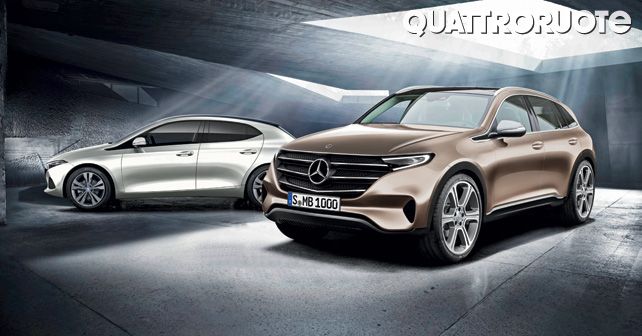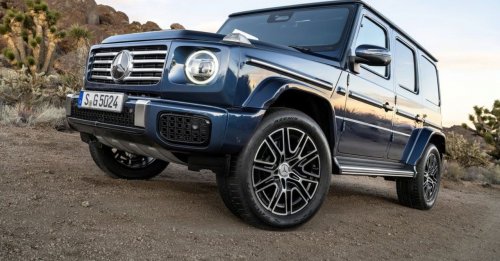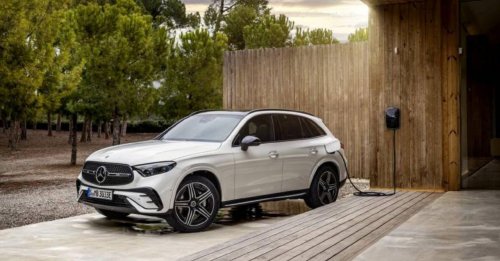Mercedes-Benz has opened yet another chapter with the EQ brand – an all-new, all-electric platform that continues to represent the brand’s core values despite being built from the ground up.
Take a moment to look at the two car models that appear on this page. Let your eyes linger on their contours, shapes and proportions, and you’ll find yourself thinking that these cars indeed belong to the future. In fact, so disparate is their appearance from the reality of our world that some might even go as far as to say that they look like alien space crafts – but, then, that would be stretching it a bit too far. For distant as they may be from the cars of our time in their appearance, they still retain a familiar shape – something that one may relate to. If you come to think about it, the futuristic air of these cars is essentially the result of their stylistic appearance. Now, many might think that Mercedes would strategically want to design its upcoming electric cars – or the EQ range as the company would like them to be called – to promote them as futuristic, something alien to the conventional image of the car. But, surprisingly, Mercedes, in all likelihood, would want its future electric cars to have a relatable and familiar shape. Why? Well, to put it simply, a familiar shape gives the new electrified vehicles a sense of continuity, a sense of relatability vis-à-vis its conventional models – it allows them not be viewed as complete aberrations.
Not your typical Mercedes
Under that combination of familiarity and novelty lies a very different technical setup – one that lacks any familiarity with the conventional setup of an internal combustion engine, quick shifting gearboxes or any other components that would remind you of a typical Mercedes.
It’s not news that Mercedes-Benz is investing heavily in the development of electric cars – there’s been an enormous financial effort (approximately 11 billion Euros worth) to push its electric car programme. The results of this will be visible from as early as 2019, which is when Mercedes is expected to launch the EQC – a standard sport utility derived from the Generation EQ concept that was first showcased at the 2016 Paris Motor Show. The EQC won’t just be a one-off electric vehicle. In fact, the EQ platform is likely to spawn a complete new range of Mercedes branded electric vehicles. In the next few years, Mercedes plans to introduce 10 fully-electric vehicles. But things don’t end here – there’ll be as much as 50 new electrified vehicles, including hybrid models – most of which will be launched between 2019 and 2022. The EQ range’s first model will be an SUV, which is expected to be followed by the launch of the EQA hatchback. And, then, there’s also a possibility of another vehicle with notchback styling.
Common architecture
As a common element, the first three electric models of Mercedes won’t just feature the same initials but also the same architecture. The EQ vehicles will be based on an all-new platform, which is built from the ground up. According to Mercedes, the platform allows maximum modularity and is also scalable. The first production model, the EQC SUV, is expected to roll out in 2019. With a mix of aluminium and carbon, the architecture of this car is definitely innovative. Each axle will have its own electric motor. The total system output should be around 400bhp and 700Nm. The lithium-ion battery pack will be developed by Daimler, with a capacity of around 70kWh – ensuring a driving range of 500kms on a single charge. If Mercedes is to be believed, the EQC will be the most efficient vehicle in its segment once it goes on sale.
Three years on
Next in line for launch is the compact EQA hatchback, albeit that’s not until 2021 – three years after the EQC. Technically, it’ll have a different setup from the SUV – it’ll feature a smaller 60kWh battery with a range of 400-kilometres. The company is also likely to offer it in different variants. Besides the powerful version – with an electric motor on each axle and a power output of around 270bhp – there’s a possibility of a simpler and more affordable version featuring a single motor configuration, with power being sent to just one axle. Interestingly, after the EQA, there’s a good chance that Mercedes will bolster the EQ range with a notchback – likely to be dubbed the EQD. As the name suggests, the size of this car will be somewhere between the C-Class and E-Class. With a compact but stylish exterior design, it’ll have a spacious and luxurious interior. And given the fact that it’ll be an all-electric vehicle, its interior will be more spacious than, say, the standard E-Class (not the LWB version, though, that’s sold in India).
Opposite philosophies
Mercedes’s electrification plan is based on a long-term vision that takes into account various strategic aspects, such as cost and economies of scale. You see, the EQ platform is all new and not a derivative of the company’s traditional models. It’s a step that requires a lot of effort and a discernible investment. And any company in such a position would try to rationalise its decision and investment. “Six years ago,” said Dieter Zetsche at the 2018 Detroit Motor Show “we spent eight billion Euros in research & development and on capital investments. Now, we’re at 14 billion. And, notwithstanding our strong position, we need to make some choices now.” Choices that, regardless, won’t cut any investments from the EQ brand. “Zero emission vehicles will soon debut, and we’re not going to produce fully electric versions derived from traditional Mercedes Benz models,” affirms Britta Seeger, the sales head for the group. Mercedes’ perspective on electrification is quite interesting, especially when you compare it with BMW’s philosophy. Unlike its rival from Stuttgart, BMW is planning to expand its EV range using its current model platforms – starting from the X3 and Mini. Which approach is more likely to succeed in the long run? Only time will tell, so all we can do is wait.
Let’s call it the EQD
The EQD could be a notchback sedan based on Mercedes’ all-electric EQ platform. It’ll be the third model in the fully-electric range, after the EQC and EQA. From what we can tell, it’s going to be have a long hood and a spacious cabin. And its size should be somewhere between the current C-Class and E-Class.
Goodbye mirrors?
A small, but significant, dilemma that the company seems to have is whether to replace the rear-view mirrors with reversing cameras. As facile as the problem may seem, interestingly, Mercedes hasn’t still arrived on a definitive conclusion. But given the fact that Audi’s electric e-Tron cars use high-tech AMOLED screens as rear-view mirrors, one can speculate that Mercedes is also likely to take the same cutting-edge route for the entire EQ range. There is, however, a bureaucratic obstacle in the European market – the homologation of such digital devices. But, it’s only a matter of time that the authorities give such technologies their nod of approval.
Smallest wonder
If the dimensions of the concept from the 2017 Frankfurt Motor Show are anything to go by, then the EQA could become the smallest model of the brand. The new A-Class is nearly 4.5 metres long, while the electric hatchback’s prototype measures only 4.28 metres.
© Riproduzione riservata































Write your Comment